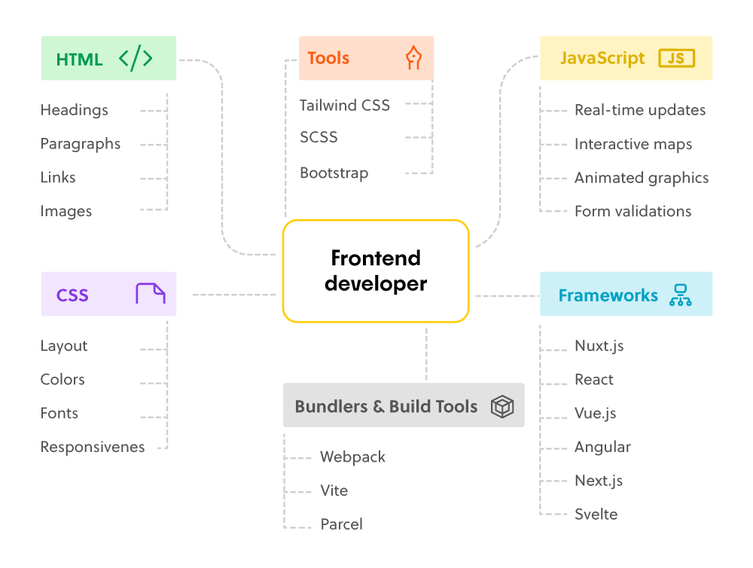5 min
July 3, 2025
Frontend vs Backend? Or perhaps a Full-Stack Developer?
In the digital age, your online presence is often the first (and most crucial) point of contact with a client. But who is behind it?
Regardless of the application's complexity, a website's success is driven by developers who, like in any industry, have their specializations. If you're wondering about the difference between frontend and backend, which path to choose, or what kind of experts your company needs, this article will answer your questions.
Listen to the audio version of this article.
Frontend vs. Backend Development - The Basics
Frontend and backend are the two pillars of all web applications. Together, they form a cohesive whole, but their functions differ significantly. Below, you'll find a comprehensive description of each area.
P.S. If I were to visualize them as two friends, the frontend developer would be the spontaneous extrovert who connects with people at parties, while the backend developer is calmer and more responsible, handling pragmatic matters like ensuring a safe return home and feeling good the next morning.
Frontend vs. Backend - Comparison Table
For easier understanding, below is a graphic summary of the differences and similarities between the two layers.
 Frontend is designed for the user, and the backend is based on infrastructure and data. In practice, they must complement each other.
Frontend is designed for the user, and the backend is based on infrastructure and data. In practice, they must complement each other.
Frontend Developer - Interface Management
The frontend is the application layer visible to the user. It is responsible for the interactive and visual aspects, including page layout, colors, animations, and responsiveness across various devices. In short, everything the user directly interacts with.
Thus, a frontend developer cares about the aesthetics and intuitiveness (UX/UI) of a website or application, making it simple, easy, and pleasant to use.
Typical responsibilities include:
Creating user interfaces (UI) consistent with graphic designs.
Implementing responsive layouts (RWD) using CSS and frameworks like Tailwind CSS.
Building dynamic components with JavaScript and frameworks such as React, Vue.js, or Angular.
Optimizing page performance (e.g., lazy loading, CSS/JS minification).
Testing browser compatibility (cross-browser compatibility).
Collaborating with UX/UI designers and backend developers on integration.
As you can see, a well-polished frontend is essential for smooth user interactions with the site, and consequently, for encouraging users to use your business's offer.
I also invite you to check out the following posts on our blog – you'll learn what frontend in e-commerce is and why it's the future of conversions.
Frontend Technologies
This type of developer, of course, needs essential technologies to work to ensure the proper functionality of your website. These include:

Advantages and Challenges for a Frontend Programmer
This paragraph is primarily for those considering their career path. Like any profession, it has its pros and cons.
Programmers in this specialization often appreciate:
High creativity: The ability to create visually appealing interfaces.
User proximity: Direct impact on user experience (UX).
Quick results: Outcomes are immediately visible in the browser.
Dynamic technology development: Access to modern tools and frameworks like React or Tailwind CSS.
Collaboration with designers: Interesting work with creative teams, e.g., UX/UI.
Frontend development also poses certain challenges:
Browser compatibility verification: The need to test programs on various devices and browsers.
Rapid trend changes: The need to constantly follow new libraries and design styles.
Difficult performance optimization: Balancing aesthetics with page loading speed.
Framework complexity: Learning advanced tools like Redux or Next.js can be time-consuming.
Specialized design knowledge: Collaboration with designers requires an understanding of UX/UI principles.
Backend - Web Development Behind the Scenes
The backend is responsible for servers, databases, application logic, and integrations with external services (payments, ERP, CRM). In other words, it's the "brain" of your e-commerce – it lays the foundations for building websites.
A backend developer deals with the "behind-the-scenes" part of a website. They ensure the stability and security of the application, allowing the user to smoothly interact with the frontend part. They are responsible for:
Designing and implementing APIs (REST, GraphQL) for communication with the frontend.
Managing databases (e.g., MySQL, PostgreSQL, MongoDB).
Creating business logic in languages such as Python, Node.js, or Java.
Implementing authorization and authentication (OAuth, JWT).
Optimizing server performance and application scalability.
Integrating with external services.
Monitoring and debugging server issues.
Now you see that this "behind-the-scenes" work is just as important as the frontend's leading role – without a proper director, they won't work.
Most Popular Tools
In this case too, to properly run web applications, a backend developer needs to be proficient in the right technologies:
Programming languages: Python (Django, Flask), Node.js, PHP (Laravel), Java (Spring), Ruby (Rails).
Databases: MySQL, PostgreSQL, MongoDB, Redis.
Server tools: Docker, Kubernetes, Nginx, AWS.
Monitoring and debugging: New Relic, Loggly, Postman, server console.

Pros and Cons of Working as a Backend Developer
Both frontend and backend specialists find things they appreciate and those they don't necessarily like in their profession.
The most frequently mentioned advantages are:
Project stability: Working on the stable foundations of an application.
Deep and precise technical knowledge: The ability to specialize in databases, scalability, or security.
High demand: Especially in fintech, big data, and distributed systems sectors.
Greater stability and independence: Focus on logic rather than rapidly changing styles.
Impact on performance: A key role in ensuring the speed and reliability of applications.
Nothing is perfect, and in the case of the backend, there are also disadvantages:
System complexity: Working with distributed systems and integrations can be complicated.
Responsibility for security: Protecting data and preventing attacks.
Complex debugging: Server problems can be harder to diagnose than in the frontend.
Longer learning process: Designing systems for heavy loads requires advanced knowledge.
Less visible results: "Behind-the-scenes" work may be less satisfying if you like to see tangible results of your efforts.
Full-stack Developer vs. Frontend and Backend - Similarities and Differences
A full-stack developer is a jack of all trades – a programming handyman who combines frontend and backend skills. They create products from the user interface to application logic and databases. This is a person who knows the entire software development process, from graphic design to server infrastructure.
Full-stack developers are particularly valued in smaller teams and startups where versatility is key. Their tasks include:
Building complete web applications: from UI design to API and database implementation.
Integrating frontend with backend, e.g., connecting React with Node.js or Django.
Creating and optimizing APIs (REST, GraphQL) for communication between layers.
Managing the full project lifecycle: from prototype to deployment and maintenance.
Debugging issues on both the client side (browser) and the server side.
Collaborating with designers, DevOps, and project stakeholders.
Maintaining code in both layers (frontend and backend) according to best practices.
Most Popular Technologies
As you might guess, a full-stack developer will need both frontend and backend tools.
Frontend: React, Vue.js, Angular, Tailwind CSS, Webpack, Vite.
Backend: Node.js, Python (Django, Flask), PHP (Laravel), Java (Spring).
Databases: MongoDB, PostgreSQL, MySQL, Firebase.
DevOps tools: Docker, Kubernetes, CI/CD (GitHub Actions, Jenkins).
Debugging and testing: Chrome DevTools, Postman, Jest, and Cypress.
Project management: Git, Jira, Trello.
Hiring a full-stack developer can be more costly, but you get what you pay for.

Is It Worth Being a Full-stack Developer?
I can't answer that for you. To help you find the answer to this question, I've compiled frequently mentioned full-stack advantages:
Versatility and decision-making: The ability to work on every aspect of a project, from UI to the server.
Flexibility: Easier adaptation to different roles in a team.
Understanding architecture: Better "big picture" view of the application.
Market attractiveness: Particularly sought after in startups and smaller companies, but large businesses also value versatile programmers.
Of course, there are also challenges:
Broad knowledge scope: The need to learn and follow trends in both fields.
Risk of lack of specialization: The possibility of being "good at everything, master of nothing."
High responsibility: Often requires managing the entire project, which can be stressful.
Time-consuming learning: Maintaining a high level in both frontend and backend requires continuous self-improvement.
How to Choose the Right Specialist for Your Project?
There's no single answer – it all depends on:
Project goal (whether it's a redesign, integration, or MVP)
Budget (whether you can hire separate individuals)
Development pace (whether you need to scale the team quickly)
Technology (e.g., headless commerce will require someone with specific knowledge).
If you are an e-commerce owner planning to expand your system, start with an audit: what works and what needs to be rebuilt. Based on this, you will choose a specialist who will not just "do" but "solve the problem."
When to Opt for a Full-stack Developer?
Of course, full-stack doesn't always mean "expert in everything," but rather "a person who understands both worlds and can connect them in practice." Therefore, consider if:
You are creating a startup idea.
You have a limited budget and want to act quickly.
You want to build a demo or proof of concept.
Choose them if you need someone who understands the "big picture" of the product. One specialist – fast iteration, lower costs.
However, if you have larger funds, it's worth considering a more complex team with specific specializations. Each of them will refine your business in the finest detail according to their specialized knowledge.
How Does the Division Look in Reality?
The truth is, a good developer will be familiar with both layers. The division into frontend and backend is becoming increasingly fluid. A frontend developer no longer deals solely with the "visual side" of an application. Increasingly, they also need to write server-side code (e.g., API routes, middleware), configure proxies, implement business logic, and understand application architecture. These are things that, just a few years ago, were part of the backend.
However, even if a frontend developer creates APIs or serverless functions, it doesn't necessarily mean they are creating a "full-fledged" backend with all its architecture, scalability, security, or integrations with other systems. Therefore, the role and value of a backend developer remain very important. The only area they usually don't directly touch as frontend developers is databases. However, even here, it's worth having a basic understanding – e.g., how relationships work, what an ORM is, or how to optimize queries for API performance.
Frequently Asked Questions (FAQ)
Of course, there could be many more, but let's start with the most popular ones.
Is one full-stack developer enough to start? Yes, especially for an MVP or the first version of a store. In the long run, however, it's worth splitting responsibilities.
Does a frontend developer know backend? Usually not – they may know the basics, but they don't create backend logic.
Can a backend developer do UI? Technically, yes, but UX/UI is a separate competence. The results may not meet user expectations.
How to check if a candidate is truly full-stack? Ask about specific projects where they combined both layers. Ask for a portfolio or a test task from both areas.
Frontend or Backend? Or Full-stack? - Choosing Your Specialization
The decision depends on your interests, work style, and career goals. Here's a checklist to help you choose:
Interests: Do you prefer creating beautiful interfaces (frontend), designing algorithms and databases (backend), or building entire applications (full-stack)?
Work style: Do you like experimenting with design and animations (frontend), prefer stable work on infrastructure (backend), or enjoy task diversity (full-stack)?
Career path: Do you want to be an expert in one field or a general specialist in everything?
Job market: Check local offers on portals like No Fluff Jobs or Just Join IT – in some regions, frontend developers are more valued, in others, backend or full-stack developers.
In short:
Frontend: You have a knack for design and enjoy working with interfaces.
Backend: You are interested in logic, algorithms, and scalability.
Full-stack: You love variety, learn new technologies quickly, and want to influence the entire project.
Earnings and Prospects in the IT Industry
Earnings in IT in Poland depend on experience, location, specialization, and employment type (UoP vs. B2B). Here are approximate gross rates for 2025 (source: spidersweb, No Fluff Jobs, and Bulldog Job reports):
Junior Frontend Developer: 6,000–10,000 PLN (UoP) / 8,000–12,000 PLN (B2B)
Junior Backend Developer: 7,000–11,000 PLN (UoP) / 9,000–13,000 PLN (B2B)
Junior Full-stack Developer: 7,000–12,000 PLN (UoP) / 9,000–14,000 PLN (B2B)
Mid Frontend Developer: 12,000–18,000 PLN (UoP) / 15,000–22,000 PLN (B2B)
Mid Backend Developer: 13,000–20,000 PLN (UoP) / 16,000–24,000 PLN (B2B)
Mid Full-stack Developer: 14,000–22,000 PLN (UoP) / 17,000–26,000 PLN (B2B)
Senior Frontend/Backend Developer: 20,000–30,000+ PLN (UoP) / 25,000–40,000+ PLN (B2B)
Senior Full-stack Developer: 22,000–35,000+ PLN (UoP) / 28,000–45,000+ PLN (B2B)
Backend developers often earn slightly more in sectors like fintech or big data, where knowledge of scalability and security is crucial. Frontend developers shine in projects requiring advanced SPA applications and animations. Full-stack developers have an advantage in smaller companies where versatility is valued, but they may earn slightly less than highly specialized seniors in one field.
Every Web Development Specialist Is Equally Important
The frontend is the face of your store. The backend is its heart. A full-stack developer is someone who knows both sides and can build a bridge between them. It's hard to imagine a functioning organism without any of these elements.
Choosing the right specialist is not just a technical decision – it's a strategic step that can determine the scalability, performance, and UX of your store.
Wondering how to build your dream development team? Contact us at BeeCommerce – we will advise, build, and implement a solution that truly works. Click the black button below labeled "Get an estimate."






